Posts for: dave.m
Jul 22, 2020 06:15:13 #
I joined UHH because it was an informative and useful site. People offered information and assistance. Often there is divergence, sometimes there are errors (as I have done in the past.) Other contributor often published a correction - no malice, sarcasm or nastiness.
Just lately if someone makes a mistake it often degenerates into a spiteful slanging match - a great shame.
Just lately if someone makes a mistake it often degenerates into a spiteful slanging match - a great shame.
Jul 22, 2020 06:13:11 #
User ID wrote:
History or structure of organizations is not photo... (show quote)
Kms were in existence a LONG time before even sputnik let alone surveying, and positioning systems like GPS, GLONASS, or Galileo

Jul 22, 2020 04:31:27 #
smussler wrote:
From Google search:
ISO. Stands for "International Organization for Standardization." Yes, technically the acronym should be "IOFS," but I guess ISO sounds better. The ISO works with standards institutes from over 150 countries to develop technology and product standards. ... It also leads to more standardized products for consumers.
ISO. Stands for "International Organization for Standardization." Yes, technically the acronym should be "IOFS," but I guess ISO sounds better. The ISO works with standards institutes from over 150 countries to develop technology and product standards. ... It also leads to more standardized products for consumers.
Not true. ISO is not an acronym at all, it is a single word trade name pronounced 'eye-so' not 'eye'-'ess'-'oh' as so many photographers say it! (and I used to
 )
)It is derived from the Greek isos (meaning equal, remember isosceles triangle from school). If you look at the ISO logo you will see the word ISO and a wire diagram of the world - meaning equal everywhere..
How do I know this? - it was pointed out in no uncertain terms by a senior French guy at their headquarters when I said it wrong when working there on a contract. He directed me to this quote on their web page https://www.iso.org/about-us.html -
'
"It's all in the name
Because 'International Organization for Standardization' would have different acronyms in different languages (IOS in English, OIN in French for Organisation internationale de normalisation), our founders decided to give it the short form ISO. ISO is derived from the Greek 'isos', meaning equal. Whatever the country, whatever the language, we are always ISO."
Perhaps Mr Google forgot to tell them they got it wrong!
So you too can now take the opportunity to really p*ss of other photographers by 'reaching out' and 'sharing' this with them


Jul 22, 2020 04:12:46 #
On a separate note is their an evolving sensible abreviation for a camera without a mechanical shutter? Seems strange to me to define a camera by what it doesn't have - mirrorless ??
Jul 21, 2020 15:45:20 #
Bison Bud wrote:
I for one hate the way the three and four letter a... (show quote)
I came across this years ago
https://www.businessballs.com/glossaries-and-terminology/acronyms-finder/
doesn't include DCIM but almost anything else I've ever looked for
Many are hilariously funny, many are definitely polically incorrect - the F abreviation (that my mother called the 'in out word' have been 'translated' to 'flipping' or 'fouled' or similar but you'll get the true original (I can't imaging a Marine saying 'Situation Normal all fouled up' somehow

If nothing else it will add no end of TLAs, FLAs, etc to drop into your cocktail party conversation

Jul 18, 2020 02:37:41 #
rmalarz wrote:
Dave, please explain the "... but often with blocking of shadow detail" in your statement "ETTR/EBTR (Exposure to the right/ beyond the right) will certainly get all the highlights (and more detail if BTR is appropriate) but often with blocking of shadow detail".
--Bob
--Bob
rmalarz wrote:
Dave, please explain the "... but often with blocking of shadow detail" in your statement "ETTR/EBTR (Exposure to the right/ beyond the right) will certainly get all the highlights (and more detail if BTR is appropriate) but often with blocking of shadow detail".
--Bob
--Bob
Hi Bob,
The below screen grab explains it visually better than I can. (I can't recall where I got it from so can't give proper credit but if someone recognizes it perhaps they can)
It illustrates what we might typically get if we took 3 exposures for HDR/ Exposure stacking,
The 0ev (middle) histogram illustrates what we would perhaps get with an exposure metered as per camera defaults. Note the clipping on L and R (where the histogram is 'piled up' on the left and right side) The left clipping is where the sensor was unable to separate fine shades of low light and they have all been blocked into a single shade, typically pure black. The right side is where the various bright shades have been combined to white so the detail is 'blown out'. So the full range of detail has been 'clipped' off in shadows and highlights.
Now look at the right hand image where the exposure has been made so that the histogram 'piling up' to the left hand (dark side) is reduced to almost nothing. This means that all the shadow detail than can be captured has been and the various dark shades have not been clipped and blocked together - effectively 'exposed to the left' ETTL to keep detail in the shadows. It has of course clipped or 'blown out' even more of the highlights on the right.
The left hand histogram is reversed although there is still some clipping of the highlights it is much less than the 0EV middle exposure. This is EBTR (exposure beyond the right) and assumes that processing the RAW data will be able to recover even that data just past the edge of the histogram (remembering that any histogram is from the internal JPEG and the RAW data will contain more)
What HDR/ exposure blending software does (either in your editor of choice or standalone like PhotoMatix), is to build a single image which shows detail across the entire range. Although combination of fine shades happens, it is spread across the entire spectral range not concentrated at the shadow and highlights only.
Hope that helps
Dave

Jul 17, 2020 16:59:31 #
rmalarz wrote:
Dave, please explain the "... but often with blocking of shadow detail" in your statement "ETTR/EBTR (Exposure to the right/ beyond the right) will certainly get all the highlights (and more detail if BTR is appropriate) but often with blocking of shadow detail".
--Bob
--Bob
Hi Bob,
The below screen grab explains it visually better than I can. (I can't recall where I got it from so can't give proper credit but if someone recognizes it perhaps they can)
It illustrates what we might typically get if we took 3 exposures for HDR/ Exposure stacking,
The 0ev (middle) histogram illustrates what we would perhaps get with an exposure metered as per camera defaults. Note the clipping on L and R (where the histogram is 'piled up' on the left and right side) The left clipping is where the sensor was unable to separate fine shades of low light and they have all been blocked into a single shade, typically pure black. The right side is where the various bright shades have been combined to white so the detail is 'blown out'. So the full range of detail has been 'clipped' off in shadows and highlights.
Now look at the right hand image where the exposure has been made so that the histogram 'piling up' to the left hand (dark side) is reduced to almost nothing. This means that all the shadow detail than can be captured has been and the various dark shades have not been clipped and blocked together - effectively 'exposed to the left' ETTL to keep detail in the shadows. It has of course clipped or 'blown out' even more of the highlights on the right.
The left hand histogram is reversed although there is still some clipping of the highlights it is much less than the 0EV middle exposure. This is EBTR (exposure beyond the right) and assumes that processing the RAW data will be able to recover even that data just past the edge of the histogram (remembering that any histogram is from the internal JPEG and the RAW data will contain more)
What HDR/ exposure blending software does (either in your editor of choice or standalone like PhotoMatix), is to build a single image which shows detail across the entire range. Although combination of fine shades happens, it is spread across the entire spectral range not concentrated at the shadow and highlights only.
Hope that helps
Dave

Jul 17, 2020 12:01:42 #
The human eye is amazingly adaptable and it is suggested capable of between 14 to 24 stops. 14 to 18 stops is not uncommon at all under wide lighting conditions.
Many cameras claim to record 14 stops dynamic range but according to DXOmark 10 to 12 is more likely.
ETTR/EBTR (Exposure to the right/ beyond the right) will certainly get all the highlights (and more detail if BTR is appropriate) but often with blocking of shadow detail. Most of the time that doesn't matter as the highlights are what the photographer and viewer are interested in. Similarly ETTL/EBTL is more relevant if the shadow detail is important but then often with highlight clipping.
Exposure blending /stacking or HDR then has a place to play as it 'shares out' the clipping (for lack of a better description) so detail is present from the lowest shadows to the highest highlights.
So when you can't get it right in camera because the scene has 16 stops you want to show, your camera only does 10 stops in RAW and jpeg compresses that to 8bit for the end result, then exposure stacking / HDR most definitely helps show what you visualised.
Many cameras claim to record 14 stops dynamic range but according to DXOmark 10 to 12 is more likely.
ETTR/EBTR (Exposure to the right/ beyond the right) will certainly get all the highlights (and more detail if BTR is appropriate) but often with blocking of shadow detail. Most of the time that doesn't matter as the highlights are what the photographer and viewer are interested in. Similarly ETTL/EBTL is more relevant if the shadow detail is important but then often with highlight clipping.
Exposure blending /stacking or HDR then has a place to play as it 'shares out' the clipping (for lack of a better description) so detail is present from the lowest shadows to the highest highlights.
So when you can't get it right in camera because the scene has 16 stops you want to show, your camera only does 10 stops in RAW and jpeg compresses that to 8bit for the end result, then exposure stacking / HDR most definitely helps show what you visualised.
Jul 17, 2020 07:26:59 #
bbradford wrote:
What would you use for steps on exposure bracketing. Would you use 1/3 , 1/2, 3/4, or 1 full step?. How many pics would you use? 3, 4, 5 ? Thanks all
When I used a conventional DSLR (EOS 6D) if necessary - and if I had time - I would spot meter the highlights and shadows and then typically use 3 exposures equally spaced between them.
Since I have upgraded (yes I mean that guys :) to mirrorless its really easy as I can display the histogram in real time in the EVF or on the screen. I now wind the exposure compensation dial to the right so no clipping of the shadows for one exposure, another with histogram centred (clipping left and right), and the final with compensation to the left (no clipping in highlights). Given that the histogram is a representation of the JPEG view, and knowing my camera because I tested it, I know that he RAW image will have at least 1/2 stop of detail beyond what the histogram displays.
With histogram in the EVF this takes about 20x longer to describe than it does to do!
If the scene has dynamic content(eg with people, animals moving, wind blowing the trees etc ) I typically set burst mode on the camera, and then set Automatic Exposure bracketing (AEB) to +/- 1.5 to 2 stops (subjective guestimate based on how contrasty the scene is). Then a 1/2s or thereabout press of the shutter gives me 3 exposures so close together that movement is negligible. Also to reduce time between exposures further, set to manual focus for burst mode exposure. This too is an absolute doddle on the EOS R (and other mirrorless I'm sure) because of the display of real-time exposure peaking in the EVF.
I too use Photomatix. It doesn't do loads of things, but what it does do (HDR and exposure stacking) it does exceptionally well.
Worth noting also, that Photomatix will also easily process exposure stacking from a single raw image. I use this quite a bit as I know my particular camera has 1/2 to 1 stop more than the histogram displays. (even if you take raw only, the camera shows the histogram of the embedded jpeg file. Its also a great technique for dynamic content.
Just open in Photoshop or your preferred RAW processor, save 1 image 'as is', save another with increased exposure to remove as much shadow clipping as possible, similarly another with decreased exposure for highlight clipping. Using Photomatix is doesn't matter if the under/over are balalanced as it allows me to enter different values for each image. Works a treat.
Here's an example of a single RAW converted to +/- 1.5 and a resulting exposure blend. To be fair the bridge wasn't moving much but the US flag and the trees were
 Screen grabs only as originals were huge
Screen grabs only as originals were hugeimages: -1.5; original; +1.5 using adobe camera raw; after Photomatix exposure blend, PS classic, Topaz denoise
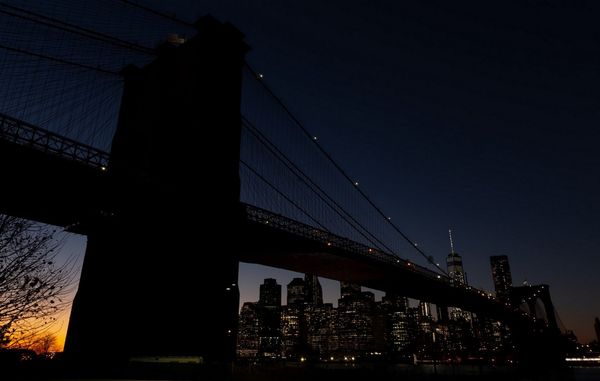
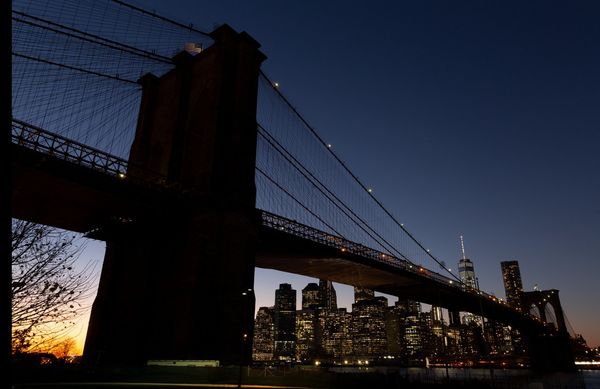
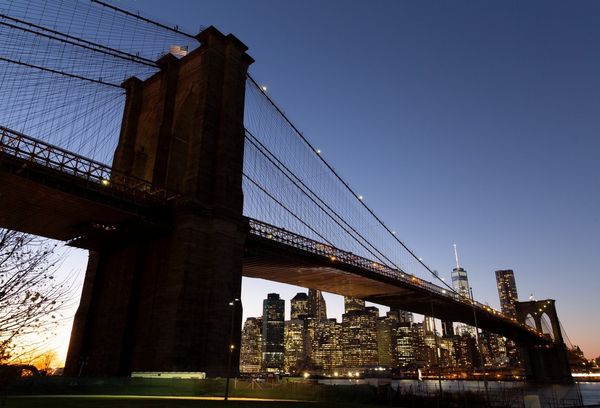
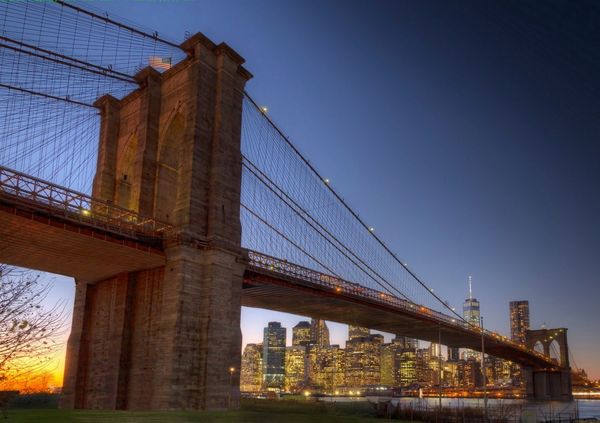
Jun 20, 2020 06:46:03 #
SuperflyTNT wrote:
40-50% is definitely not lossless, and the loss comes with the detail in the highlights and shadows that gets tossed out in the jpeg. There’s a big difference in a 14 bit raw file and an 8 bit jpeg. As Gene stated, you can get excellent results with average scenes, but high contrast scenes are a different story. With a 14 bit raw file I can pull in detail from the highlights and shadows that will be gone with a jpeg.
first reply that identifies the big issue!
jpeg is 8bit and that's it. Consider that for monochrome only (colour is the same in each of RGB) that means the maximum it can record from 0 (black) to 1 (pure white) is 8 stops. The internal raw to jpeg algorithm must select / merge in some way to compress. Amongst other things it often involves clipping.
Most modern cameras have a 12bit or 14 bit sensor so can in theory manage that 12/14 stops. 10 to 12 depending on manufacturer is practically more realistic.
So as mentioned elsewhere: if you like the manufacturer's algorithm (Fuji often gets great reviews on their colour etc), and you are viewing on a phone/ pad/ internet, then jpeg will meet most if not all your needs.
It comes unstuck when the scene has very high dynamic range, or the internal jpeg conversion misses what you wanted to see.
A common example is a sunrise/ sunset where that fabulous sky looks washed out or the sky is ok but the foreground is almost black. There are several others but in cases like that raw gives you the potential to recover highlights and shadows to your preference which can never be achieved to the same level with jpeg
Jun 8, 2020 05:03:01 #
alawry wrote:
Down here in NZ we have a particular tree! https://www.google.com/search?q=the+wanaka+tree&client=firefox-b&sxsrf=ALeKk03OgDVdfFPFy3rgBWQXBMXDrNZVpQ:1591522820005&source=lnms&tbm=isch&sa=X&ved=2ahUKEwibgtrCtO_pAhXBF3IKHcJzBuYQ_AUoAXoECB0QAw&biw=1184&bih=564 I can't figure it out either... but there are a lot of nice photos. Cheers.
unfortunately now vandalised apparently. Here is a stunner of it (not my photo but I wish it was) before it was attacked
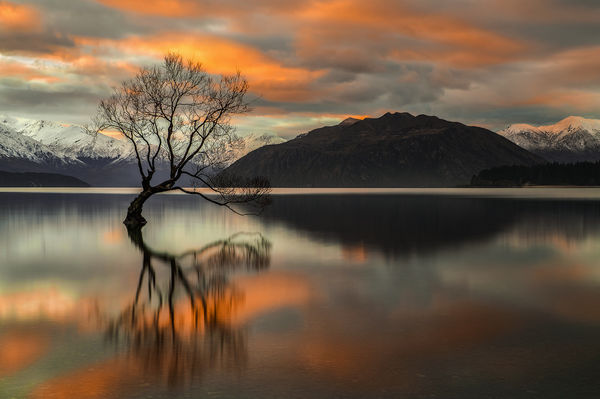
Jun 5, 2020 17:18:11 #
Jun 5, 2020 09:12:25 #
ronichas wrote:
I have been to Tanzania, Namibia and Kenya. All three do not allow guests out after sundown or before sunrise. It is not safe, as many of the animals do hunt and eat at night. In Kenya, we each paid $100 to get an off road pass, if found off road without one, there is a large fine.
I have not been to S. Africa.
I have not been to S. Africa.
I'm not sure of the specific rules in S. Africa. We were on a privater reserve at Sabi Sands right on the edge of Kruger National Park. While the land was privately owned and restricted to reserve vehicles there were no fences and animals wandered freely everywhere. An amazing experience which meant we had armed guards escort us to and from the cabins to the lodge for meals in the evening.
Most of our trips were just after dawn or before dusk as at that time the animals were most active in our location. We were fortunate our guide was a particularly keen conservationist and was particularly careful not ro do anything that would stress the animals (or the customers!)
As you mention only a limited number of off road passes were available which our vehicle / guide / tracker had. They also carried some very heavy duty firearms just in case, but I never saw them reach for them at any time.
In KNP which we went into a few times, rangers were checking any private vehicles for correct passes and weapons. I guess they knew which of the local safari vehicles were properly licensed.
Jun 5, 2020 07:27:27 #
Retired CPO wrote:
I don't know if you have ever been on a African Ph... (show quote)
Something similar happened to my wife and me on a photo safari in S Africa. With 4 others, we were watching lions at a kill at night from a good distance. There were leopards scattered about waiting their turn. Then 3 large adult lions stepped out of the bush adjacent to us, one flopped in front of the vehicle, another UNDER the rear seat overhanging the back where I was sat!! We were effectivey boxed in. The bush was overgrown and lush and right up to the track and there was no way we saw or heard them approach. Our tracker was sitting on a 'jump' seat attached to the bonnet of the land rover and I guess his feet were no more than a couple of yards from one, and my backside less than that from another (fortunaltely I had the steel frame of the seat between me and the lion. Photo is one in front, very well fed as you can see
Having been well briefed by our guide each time we went out, we all sat very still and quiet until they moved onto the kill.
And yes, the guide made the rules (not guidance) very clear, and he was definitely in charge.
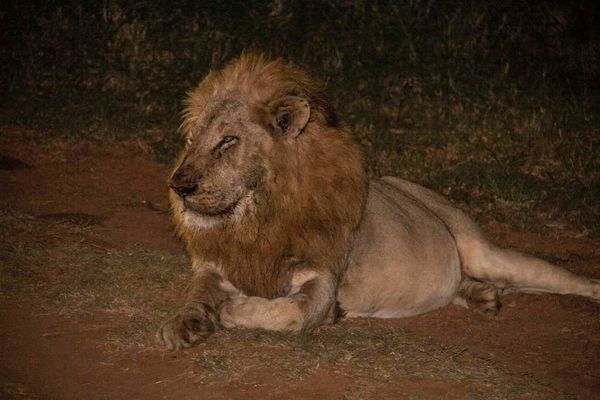
Jun 1, 2020 08:13:49 #
no 1. and 6. WOW!
the rest - Terrific shots, any one of which most would be glad to get just one of
the rest - Terrific shots, any one of which most would be glad to get just one of